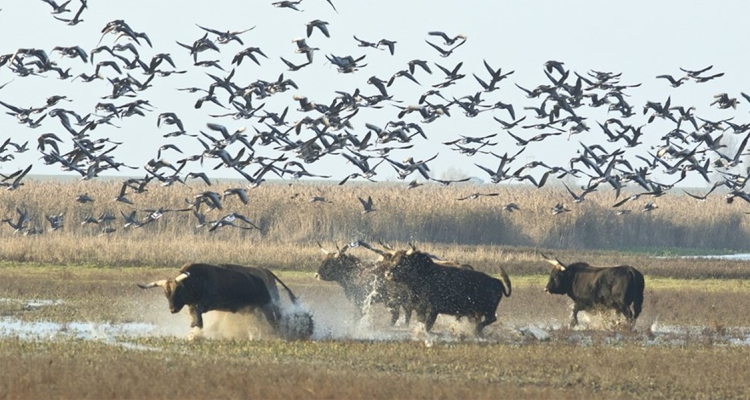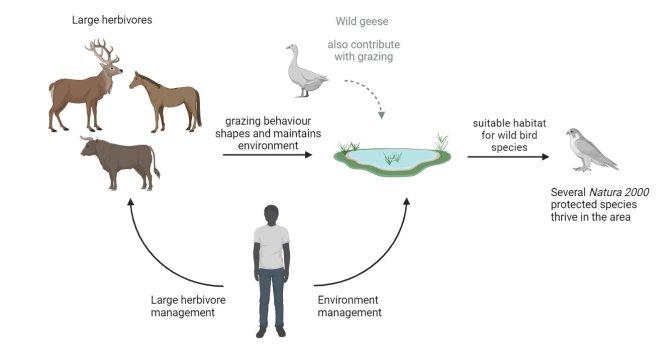
Monitoring health of large herbivores in nature reserves in the Netherlands
WIAS Magazine - Fall edition 2023
Research Overview
Key words: large herbivores, nature reserves, (zoonotic) pathogens, animal health
Nature reserves and other protected areas are crucial for the preservation of biodiversity. In countries of the European Union, including the Netherlands, there are several nature reserves that belong to a network of protected areas, called Natura 2000, which aim to protect several different animal species and their respective habitats, with the fundamental goal of safeguarding biodiversity in Europe (1). To achieve these goals, many reserves are managed with the help of large herbivores. Through their grazing behaviour they play an important role in determining changes in the structure and diversity of the ecosystem (2) needed for the conservation of biodiversity.
In these nature reserves some challenges may occur, not only due to some of its characteristics, but also because humans determine several conditions through management. Management decisions regarding large herbivores in nature reserves will have an impact on animal health and welfare, and the environment of the reserves. Consequently, impacting the biodiversity conservation efforts in the area. Thus, understanding the effects of the animal management, together with animal health status and health risks present in the environment, is essential to guarantee the welfare of these animals and the optimal functioning of the reserve’s ecosystem.
In my PhD project, I will focus on the herbivores present at the Oostvaardersplassen (OVP) Natura 2000 nature reserve, which is also part of the National Park Nieuw Land. This nature reserve is an example of a novel ecosystem sustained by human stewardship and became a very important habitat for bird species, previously rare or completely extinct as breeding species in the Netherlands. Three types of herbivore species, Heck cattle, konik horses, and red deer living together, create a diverse landscape and maintain grasslands for protected bird species (3) (Figure 1). The aim of managing large herbivores at the OVP, is to facilitate appropriate animal welfare, with emphasis on the physical health and social behaviour of the animals. To maintain a resilient and healthy population, a veterinary surveillance plan is established to avoid animal diseases associated with animal husbandry and public health.
The aim of this PhD project is to study current and past health status, and potential future health risks of large herbivores in OVP, as well as to validate animal health parameters to better assess herd health, based on data collected through the ongoing monitoring programme. In summary, historical data will be used to determine the prevalence of different pathogens in the animal populations at the reserve, along with trace mineral levels. These will be used to study and determine suitable reference animal health parameters, as health in large herbivores can be monitored through essential mineral concentrations, and deficiencies can negatively impact animal health. Field work will be undertaken to investigate the presence of ticks and the prevalence of vector-borne pathogens to gain insights into potential new and emerging animal health threats. Lastly, an animal health risk-assessment model will be developed regarding the main agents identified to be circulating in the population.
The scope of the project and variety of activities will be a great learning opportunity, and with each part of my PhD, I hope to acquire a deeper understanding of these animal populations. I will contribute to future animal management decisions in OVP, and consequently safeguard the health and welfare of these free roaming large herbivores. This work could be used as a guide for other nature reserves in the future.

Figure 1 – The ecosystem at the Oostvaardersplassen. This figure depicts a simplified representation of part of the ecosystem at the nature reserve, in which large herbivores take a more central role. The large herbivores through their grazing behaviour shape and maintain the grasslands. Consequently, the area becomes attractive to geese, creating this way a suitable environment for several protected marsh and water birds. Human management for the animals and other processes in the environment have an impact on the ecosystem, therefore are always considered. (Created with BioRender.com)
References:
- European Comission. Natura 2000.: European Comission; 2022 [Available from: https://ec.europa.eu/environment/nature/natura2000/.
- Gordon IJ, Hester AJ, Festa-Bianchet M. REVIEW: The management of wild large herbivores to meet economic, conservation and environmental objectives. Journal of Applied Ecology. 2004;41(6):1021-31.
- Vera FW. Large-scale nature development--The Oostvaardersplassen. British wildlife. 2009;20(5):28.





